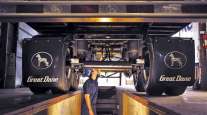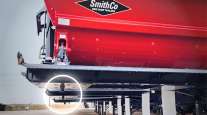Floor Makers Using New Materials, Designs to Meet Fleet Demands for Longer Trailer Life
This story appears in the Nov. 28 print edition of Transport Topics.
Fleets today are running their trailers longer than they ever have, and they expect trailer suppliers to make products that can meet higher standards.
And one of the key elements in trailers that fleets focus on is the durability and serviceability of the floors on which the freight sits during its journey through the supply chain.
Trailer floor makers say they are up to the new challenges their customers impose upon them and are turning to new wood products, new synthetic alternatives and additional reinforcing to meet the demand. The manufacturers say they are producing floors that have more weight-bearing capacity and are durable, versatile and inexpensive to make.
Some trailer makers offer their own floors on vans, but third-party suppliers are a major force in the flooring sector.
Officials at Havco Wood Products LLC, Scott City, Mo., said trailer useful-life, or trade, cycles have lengthened the past five years from a five- to eight-year range to between 12 and 15 years, and some observers point to a 20-year life cycle.
“Fleet operators are saying they want trailers to last longer,” said John Carr, vice president of sales and marketing at Havco.
Jim Jannell, U.S. sales manager for Prolam Floors, a laminated-floors producer based in Cap-Saint-Ignace, Quebec, agreed.
“Bottom line, fleets are demanding increased longevity,” he said.
“We . . . are testing a new laminated wood floor that has a bonding agent on the bottom side,” said Mike Grima, vice president of maintenance for Con-way Freight — a unit of Con-way Inc., which is based in Ann Arbor, Mich., and which ranks No. 3 on the Transport Topics Top 100 list of the largest U.S. and Canadian for-hire carriers.
“The bonding agent provides an additional level of protection and strengthens the floorboards against delamination. We believe this bonding agent will increase the life span of the wood floor.”
Bill Bliem, vice president of maintenance at NFI Industries, said his fleet also has been conducting tests. The Cherry Hill, N.J., freight-transportation company ranks No. 24 on the for-hire TT 100.
“We started putting composite flooring in two years ago, so we have yet to complete an entire life cycle,” he said. “What we’re seeing indicates that they will have a longer life span. Composite floors certainly seem like they are holding up better on a wear-and-tear basis, especially due to the bottom laminate that [wards] off decomposition.”
Bliem said he has noticed increased longevity in an important component of trailer floors.
“What’s obvious is that we’ve noticed an increase in the life span of cross members that hold up the floor,” Bliem said. The cross members give the floor strength, adding to the longevity of the floor.
On Nov. 21, Wabash National, a trailer maker based in Lafayette, Ind., introduced a new trailer with an “extreme-duty” floor that has a load rating of 35,000 pounds, which company representatives said far exceeds an industrywide standard of 18,000 pounds.
“It’s the strongest available [flooring] in the industry to date,” said Tom Rodak, corporate marketing director for Wabash National.
And fleets have definite expectations for the life span of their trailers and flooring.
“Life expectancy is 10 years for the trailer. The floor is expected to last seven to 10 years,” Con-way’s Grima said.
“Our expected life cycle is 12 years for both the trailer and the floor,” NFI’s Bliem said.
Grima said all of his company’s trailers are made by Road Systems Inc., Searcy, Ark., a wholly owned Con-way Inc. subsidiary that sells its products to other trucking companies. He said RSI purchases laminated wood planks in various lengths and then configures them for installation in Con-way Freight’s approximately 25,000 trailers.
And Julie Eck, marketing and business development manager for Specialized Transportation Inc., said, “STI’s trailer life cycle is around 10 years. Our flooring typically lasts the expected 10-year life cycle.”
STI, Fort Wayne, Ind., is a unit of CRST International, Cedar Rapids, Iowa, which ranks No. 26 on the for-hire TT 100.
The consensus among manufacturers seems to be optimism on the widespread salability and use of the newest products. They cite cost and fuel savings and reducing environmental damage.
The rule of thumb is hardwood floors in dry vans and flatbeds, and aluminum floors in refrigerated vans, representatives for several companies said.
Laminated wood is the apparent standard for dry van flooring, with oak the most popular and maple a distant second, but wood is facing a challenge from synthetic materials.
DuraPlate products, which Wabash National developed, have a high-density polyethylene core and a baked-on, galvanized polyester finish, according to information on the company’s website.
XD35 offers versatility that can reduce costs, Rodak said. For instance, that flooring enables delivering aluminum or steel coils in a dry van, eliminating the need to haul it in a flatbed.
Using flatbeds requires tarping and security measures, he said. “It’s very time-intensive, and there’s a safety factor there as well,” he said.
Havco uses oak exclusively, said Carr and Gopal Padmanabhan, the company’s vice president of product development.
So does St. Louis-based Xtra Lease, which rents and leases trailers. “We think oak is still the best solution out there,” senior vice president Steve Zaborowski said. Xtra Lease is a Berkshire Hathaway subsidiary.
Oak is slower than maple to rot or deteriorate and is less likely than maple to split when nails are driven into it, Carr said. The resistance to nail-splitting is important when a piece of wood must be nailed to the floor to prevent cargo from shifting during transit, he said.
Utility Trailer Manufacturing Co., City of Industry, Calif., uses laminated hardwood, either pure oak or an oak-maple mix, said Chuck Cole, manager of technical sales and product training.
Some experiments with plastic and composite floors are in progress as truckers and their customers seek ways to boost weight capacity by making floors lighter and stronger. Results vary.
Havco has a patent pending on “a new version of composite floor” involving a redesign of the shiplap joint, connecting floor and crossboard, to make it more waterproof and thus stronger, Padmanabhan said.
Spacing between floor beams, also called cross members, is another area getting floor manufacturers’ and trailer users’ attention. Narrower intervals mean more strength, but they also mean more cross members and possibly more weight to the floor itself, depending on the size, weight and type of material used.
“Instead of a traditional trailer floor with 12-inch settings on the cross members, we went to 10-inch centers on the cross member setting and beefed up the floor rating to 24,000 [pounds].” Zaborowski said.
“There is some new technology out there where companies are using twin pallets and loading two pallets at a time with forklifts,” he said. “It is creating a lot more pressure on the floor rating and the ability to stand up. We wanted our customers to have more flexibility.”
Flooring material also comes into play here, Padmanabhan said. Reinforcing wood with glass composite not only doubles floor strength but also boosts screw-holding capacity, he said.
“Havco’s oak laminated and the Havco Composite Floor are used by all dry freight van trailer manufacturers in North America,” Carr said in an e-mail.
He also said that Havco’s floors are used by “various truck van body manufacturers for both original equipment and their dealers’ re-placement floor requirements.”
“The [original equipment] demand for floors is by far the [company’s] largest volume market,” Carr said.
Jannell cautioned that wood sourcing practices are just as important as wood selection and processing.
“The choice of wood species used to make a trailer floor won’t guarantee the quality or longevity of a trailer floor,” Jannell said.
“The fleet decision-makers must put more emphasis on who the producer is,’ quality of their manufacturing process, gluing process, finishing, the design of the end-jointing (examples: Zig-Zag, finger, hook) and consider other products such as moisture protection to help increase longevity and reduce maintenance issues. That’s the only way they guarantee a high-quality, long-lasting floor 100% of the time,” he said.
Jannell also said the aftermarket sales are a small portion of Prolam’s business.
“Approximately 5% to 8% of our production” goes to the aftermarket, he said. “Typically, floors sold as replacements are more expensive because they are sold through aftermarket companies.”
Prolam provides floors for several trailer manufacturers, Jannell said.
Aluminum is the standard material for reefer floors, and floor and trailer manufacturers say design is as important as the material itself; air flow is a vital atmospheric component for perishables.
Cole said UTM uses a duct floor for loads needing air flow under the cargo and a flat floor for loads that are always on pallets.
UTM, he said, has two versions of each floor: “heavy duty, which is 16,000 pounds fork-truck front-axle capacity, and a ‘high wear’ version that does not raise the capacity but has more ‘wear’ surface thickness for loading devices that abuse the upper surface of the floor.”
“Higher fork-truck capacity ratings are available and typically include closer cross-member centers: 6-, 8- or 10-inch versus our standard 12-inch centers,” he said.
“Aluminum floors are 100% welded and are impervious to moisture. UTM includes a 10-inch-high, 3/16-inch-thick integrated wear band to keep the lower area of the trailer completely moistureproof,” he said.
Wabash National uses an extruded aluminum floorboard, but Rodak declined to provide details. “How we got there is in the design, and that’s proprietary,” he said.
Transport Topics special correspondent Mindy Long contributed to this report.




